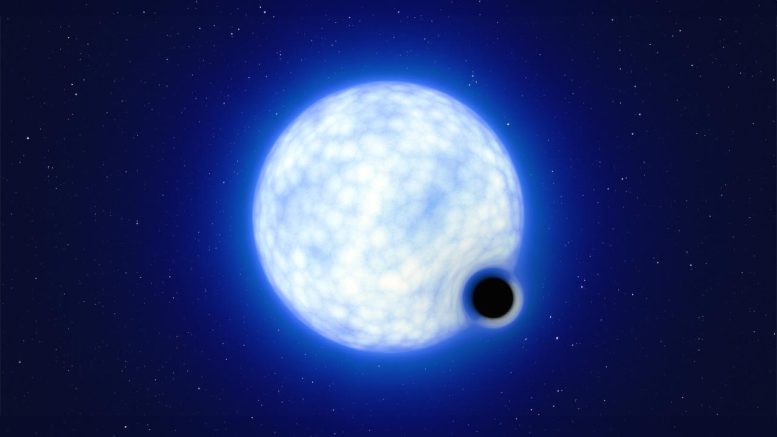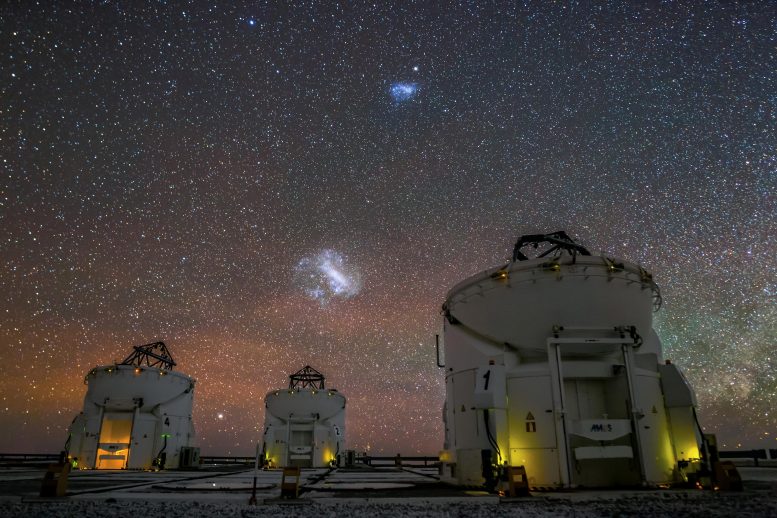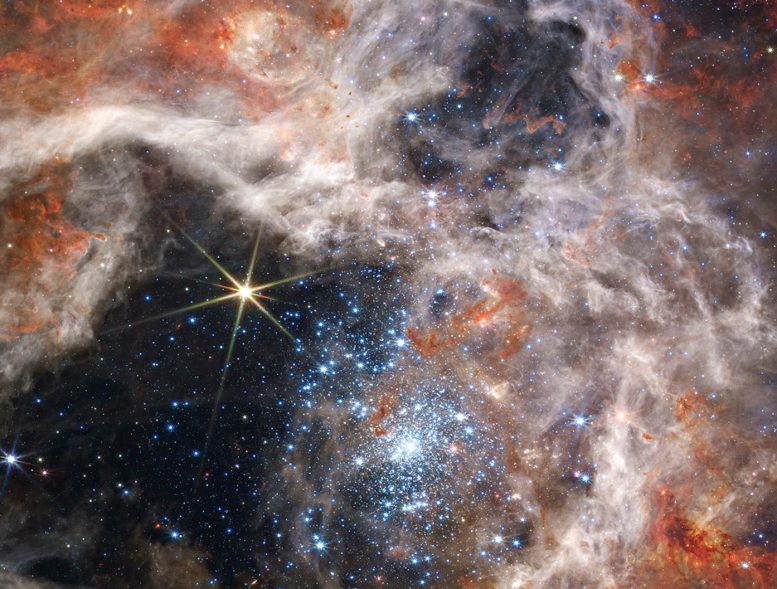
An artist’s impression of the binary system VTFS 243. Credit: ESOL. Calçada CC BY 4.0
Astrophysicists at the University of Copenhagen are helping to explain a mysterious phenomenon whereby stars suddenly disappear from the night sky. Their study of an unusual binary star system provided conclusive evidence that massive stars can completely collapse into black holes without a supernova explosion.
One day, the star at the center of our own solar system, the Sun, will expand until it engulfs Earth. It becomes increasingly unstable until it eventually collapses into a smaller and denser object white dwarf.
However, if the Sun is about eight times its mass class or more, it will go out with a huge explosion – a supernova. Its collapse culminates in an explosion, ejecting energy and mass with enormous force into space. Neutron star Or a black hole in its wake.
While this is a basic understanding of how massive stars die, there is much more to understand about the galaxies above and the spectacular deaths of these stars in particular.

The binary star system VFTS 243 is located in the „Large Magellanic Cloud”, a dwarf galaxy on the Milky Way’s periphery. The Magellanic Clouds are satellite galaxies of the Milky Way. These dwarf galaxies orbiting the galactic center are only visible from the southern hemisphere. Here, they are seen above the sub-telescopes of ESO’s Very Large Telescope (VLT) in Paranal, Chile. Credit: JC Muñoz/ESO
New research by astrophysicists at the University of Copenhagen’s Niels Bohr Institute presents the strongest evidence to date that very massive stars can succumb more stealthily and discreetly than supernovae. In fact, their study suggests that a star’s gravitational pull can be so strong that no explosion occurs once it dies. Instead, the star can go through what’s called a complete collapse.
„We believe that the core of a star can collapse under its own weight, as happens to massive stars in the final stages of their lives. But instead of ending in a bright supernova explosion, brighter than its own galaxy and expected for stars eight times the size of the Sun, the collapse continues until becoming a star. black hole,” explains first author Alejandro Vigna-Gómez, who was a postdoc at the Niels Bohr Institute when the study was conducted.
Facts and Myths: The Fading Stars
In modern times, there are many observations Stars that disappear inexplicably.
„A survey of nothing” An example is the research effort led by astrophysicist Chris Kozanek that actively seeks explanations for disappearing stars and their disappearance.
The interested reader can also explore the historical descriptions. These are often associated with stars that flash suddenly, which coincides with supernova displays. But there are other stories about stars that disappear suddenly, such as the Greek myth associated with the Pleiades constellation, commonly known as the Seven Sisters. The Pleiades myth describes the seven daughters of the Titan Atlas and the nymph Pleon. According to legend, one of their daughters married a man and went into hiding, which gives a very unscientific, but beautiful explanation for why we see it. Six stars in the Pleiades.
The discovery is linked to the phenomenon of disappearing stars, which has interested astronomers in recent years, and is a clear example and may provide a plausible scientific explanation for these types of phenomena.
“If one looks up at a visible star passing through total declination, it will be as if, in due time, a star suddenly goes out and disappears from the sky. The collapse is so complete that no explosion occurs, nothing escapes and a bright supernova cannot be seen in the night sky. Astronomers have actually observed the sudden disappearance of brightly shining stars in recent times. We can’t be sure of a connection, but the results we obtained by analyzing VFTS 243 bring us very close to a reliable explanation,” says Alejandro Vigna-Gómez.

Web Space Telescope view of the Tarantula Nebula, where VTFS 243 is located. Credit: NASA, ESA, CSA and STScI
An unusual star system with no signs of an explosion
The discovery was prompted by a recent observation of an unusual binary star system at the edge of our galaxy called VFTS 243. Here, a supermassive star and a black hole about 10 times the mass of our Sun.
Scientists are aware of the existence of such binary star systems milky way Over the decades, one of the stars has become a black hole. But the recent discovery of VFTS 243 beyond the Milky Way in the Large Magellanic Cloud is something truly special.
Facts: Black Holes
Even light cannot escape from black holes. Hence, they cannot be observed directly. However, some black holes can be identified due to the large amount of energy released from the gases swirling around them. Others, as in the case of VFTS 243, can be observed through the influence they have on the stars they orbit.
In general, astronomers believe there are three types of black holes:
Stellar black holes — such as the VFTS 243 system — form when stars with masses more than eight times that of the Sun collapse. Scientists believe there may be 100 million of these in our galaxy alone.
Supermassive black holes — 100,000 to 10 billion times the mass of the Sun — are thought to be at the center of nearly all galaxies. Sagittarius A* is the supermassive black hole at the center of our galaxy, the Milky Way.
Intermediate-mass black holes (IMBH) — 100-100,000 times the mass of our Sun — are the long-missing link. In recent years, several credible candidates have emerged.
There are also theories that describe other types of black holes that have yet to be discovered. One of these, so-called primordial black holes, may have formed in the early universe and could theoretically be microscopic.
„Typically, supernova events in star systems can be measured in various ways after they occur. But even though VFTS 243 contains a star that collapsed into a black hole, there are no traces of an explosion anywhere. VFTS 243 is an unusual system. The system’s orbit has barely changed since the star collapsed into the black hole,” says Alejandro Vigna-Gómez.
Researchers have analyzed observational data for many of the signs expected from a star system that has undergone a supernova explosion in the past. In general, they found little and unreliable evidence of such an event.
The system shows no sign of a significant „natal kick,” the acceleration of orbiting objects. It is highly symmetric, almost perfectly circular in its orbit, and residual signatures from the energy output during the previous star’s core collapse point to a type of energy consistent with complete collapse.
„Our analysis unequivocally indicates that the black hole in VFTS 243 formed instantaneously, with energy being lost mainly through neutrinos,” says Professor Irene Tambora from the Niels Bohr Institute, who participated in the study.
A benchmark system for future studies
According to Professor Tambora, the VFTS 243 system opens up the possibility to finally compare astrophysical theories and model calculations with actual observations. He expects the star system to be important for studying galaxy evolution and collapse.
„Our results highlight VFTS 243 as the best observable case of the theory of total-collapse stellar black holes where supernova explosions fail and show that our models are viable. This is an important reality check for these models. This system is an important benchmark for future research on stellar evolution and collapse. We certainly expect that to work,” says the professor.
Additional information: The missing „natal kick” and other (non-existent) signs of a supernova
No „natal kick”.
The violent forces of a supernova directly affect newborn neutron stars or black holes due to the asymmetric emission of material during the explosion. This is what researchers refer to as the „natal kick.” This kick accelerates compact material. A natal kick typically measures 100–1000 km/s for neutron stars. For black holes the velocities are expected to be slower, but still significant.
Since the black hole in the VFTS 243 system appears to have only accelerated to about 4 km/s, it shows no sign of having a substantial natal kick if it underwent a supernova.
Similarly, the symmetry of a star system’s orbit usually shows signs of having felt the impact of a violent supernova explosion because of the ejection of material that occurs. Instead, the researchers found symmetry.
„Our analysis indicates that the orbit of the VFTS is almost circular and there are no signs of major asymmetry during the collapse. This indicates the absence of a re-eruption,” says Alejandro Vigna Gómez.
A burst of energy
By analyzing the orbit of the binary star system, the team was also able to calculate the amount of mass and energy released when the black hole formed.
Their estimates suggest that the tiny kick given off during stellar collapse is not caused by baryonic matter, instead consisting of neutrons and protons, called neutrinos. Neutrinos have very low mass and interact very weakly. Another sign that the system is not experiencing an explosion.
Reference: Alejandro Vigna-Gómez, Reinhold Wilcox, Irene Tambora, Ilya Mandel, Mathieu Renzo, Tom Wack, Hans-Thomas Zanka, Julia Crestein, Julia Crestein, „Constraints on Neutrino Natal Kicks from the Black Hole Binary VFTS 243” and Thomas M. . Darris, 9 May 2024, Physical review letters.
DOI: 10.1103/PhysRevLett.132.191403
The following researchers contributed to the research:
Alejandro Viña-Gómez, Irene Tambora, Hans-Thomas Zanka, Daniel Kresse, Reinhold Wilcox, Ilya Mandel, Mathieu Renzo, Tom Walk, Julia Bodensteiner, Tomar Schenar, Thomas M. Darris
The researchers are affiliated with several research institutes:
- Niels Bohr Institute, University of Copenhagen – International Academy and DARK
- Max Planck Institute for Astrophysics, Garching, Germany
- Astronomical Institute, KU Leuven, Leuven, Belgium
- School of Physics and Astronomy, Monash University, Clayton, Australia
- ARC Center of Excellence for Gravitational Wave Discovery—OzGrav, Australia
- Center for Computational Astrophysics, Flatiron Institute, New York, USA
- Stewart Laboratory, University of Arizona, Tucson, USA
- Department of Astronomy, University of WashingtonSeattle, USA
- Technical University of Munich, TUM School of Natural Sciences, Department of Physics, Garching, Germany
- European Southern Observatory, Karching, Germany
- School of Physics and Astronomy, Tel Aviv University, Tel Aviv, Israel
- Aalborg University, Aalborg, Denmark

„Oddany rozwiązywacz problemów. Przyjazny hipsterom praktykant bekonu. Miłośnik kawy. Nieuleczalny introwertyk. Student.
